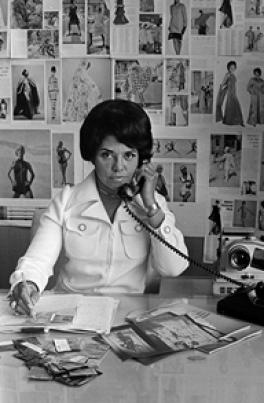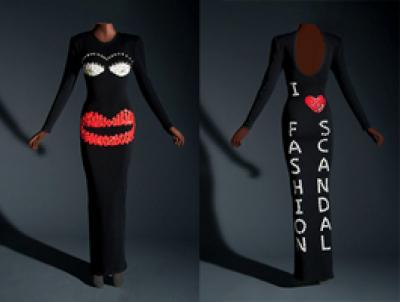Inspiring Beauty – 50 Years of Ebony Fashion Fair

by Cynthia Anderson
“...An unprecedented opportunity to show how fashion became a vehicle for African American empowerment, pride, and achievement.”
- Gary T. Johnson, President, Chicago History Museum



HISTORY
Objectives:
• To show how organizers of the Ebony Fashion Fair overcame racial prejudice to bring the pinnacle of Europe’s premier fashion to communities that were eager to see a new vision of black America (History)
• Read closely to determine what text says explicitly and to make logical inferences from it; cite specific textual evidence when writing or speaking to support conclusions drawn from the text
Activities:
1. Select two to three readings. Respond to the following questions.
Why was haute couture fashion important to the black community?
A. What are the most important points in each piece? How do you know?
B. What supporting details do the authors include to help you learn about the racial prejudices overcome through the Ebony Fashion Fair?
C. What does the author think?
Materials:
The Ebony Fashion Fair: Changing History On The Catwalk, NPR Morning Edition, by Jacki Lyden, February 15, 2014
'50 Years of Ebony Fashion Fair': Power of clothes to effect change, Chicago Tribune, March 20, 2013
Black Power Dressing, W Magazine, by Vanessa Lawrence, March 2013
How a Couture Pioneer Changed Fashion, The Wall Street Journal, by Christina Brinkley, May 23, 2012
ART
I. Design Research and Inspiration – Beginning research
The first step in creating a new design is to research fashion and consumer trends. Numerous excellent sources of fashion information, such as magazines, newspapers, pattern maker publications, trade publications, TV, specialty stores, and department stores help with the exploration necessary for fabricating design and being inspired. It is also advisable to visit fabric stores or study mail order fabric catalogues to keep up with the new fibers, processes, fabrics, and the latest fashion colors. Many of the same sources can be studied for garments, textiles, and accessories. The fashion information will show the latest garments, but the garments will also show the current textiles. The model will also be wearing accessories. It is possible to then tailor research to a specific design area.
Objectives:
• Become aware of sources of inspiration for apparel, accessory, and textile designs.
• Learn how to conduct the research necessary for creating and developing designs.
Activities:
1. Collect magazines, publications, etc. and discuss the "new look".
2. Visit a museum and websites. Describe the historical clothing. See if any of the designs have been repeated in current styles.
3. Bring "old clothing" to discuss the time periods and what could be used in current fashions.
4. Pick a time in history and talk about clothing worn during that time.
Materials/Resources:
Local History Museums
Trade Publications
• American Fabrics and Fashion
• Apparel Industry Magazine
• Fabric News to the Trade
• Stores
• Women's Wear Daily
Consumer Magazines:
Elle, Glamour, Harper's Bazaar, Mademoiselle, Seventeen, Teen, Gentleman's Quarterly, Modern Bride, Vogue
Historical Publications
• Bazaar (late 1860's to present)
• Godey's Lady's Book (1830 to late 1890's)
• Ladies' Home Journal (1883 to present)
• Le Bon Ton (1912 to 1920)
• Sears Catalogs (old reprints)
• Vogue (1893 to present)
II. Capturing Ideas – Collecting and recording ideas
Stores, malls, displays in windows, television programs, movies, videos, and historical costumes in museums are all additional ways to study fashion and get ideas. Studying nature, leaf patterns, water movement, birds, sky, architecture of buildings, etc. can inspire patterns, designs, and colors. Almost everything one comes into contact with can be a source of inspiration.
Objectives:
- Learn how to record design ideas.
- Begin collecting and organizing design ideas.
Activities:
1. Cut out pictures and start your clipping folders. Cut out any picture that has appeal, stirs the imagination, or has a pleasing detail. Keep these clippings in a folder and refer to the folder often. Add clippings constantly.
2. Designate each session for specific clothing, such as evening only or sportswear.
3. Start a sketch book (optional)
Materials:
https://fashion2fiber.osu.edu/
- Consumer Magazines: Elle, Glamour, Harper's Bazaar, Mademoiselle, Seventeen, Teen, Gentleman's Quarterly, Modern Bride, Vogue
- Folder
- Scisssors
III. Principles
Objectives:
• Understand the principles of design, which are proportion and scale, balance, unity or harmony, rhythm, and emphasis.
• Practice using design principles to achieve variety in design.
Definitions:
• Proportion is the relationship of various parts in the whole design.
• Scale refers to the overall size of an object or its parts compared other objects, shapes, or spaces.
• Balance is the sense of equilibrium and repose. It equalizes the visual weight or space of different parts of a design. There are two of balance, formal (symmetrical) and informal (asymmetrical). Symmetrical vertical balance divides the design down the center and the left side mirrors the right side. This is a more conservative style. Asymmetrical vertical balance is achieved when one side is different from the other side.
• Harmony is created when all the elements in the design come together in a pleasing, harmonious visual effect.
• Rhythm is the repeated use of lines, shapes, colors, trims, or details to create a pattern the eye can follow throughout the design.
• Emphasis or focal point creates the center of interest by focusing the viewer's attention on a specific area of the design. It adds to the interest of the design and may be created by color, line, texture, details, or accessories.
Activities:
1. Cut shapes out of construction paper. Use these shapes to demonstrate each principle.
2. Use paper to make clothes for paper dolls or magazine models to demonstrate the principles.
3. Take a trip to a clothing store. With a camera, iPad or other camera device, try to find every principle. Take pictures of each garment.
4. Use a sketch book and create a design to illustrate principles such as repetition, sequence, or alternation.
5. Use purses with different sizes and types of handles to illustrate as proportion and balance.
Materials:
Construction paper
Scissors
Paper dolls
Magazine models
Sketch book
Pictures from magazines, internet, etc.
TECHNOLOGY
Activity:
1. Create a powerpoint presentation using images from Fashion2Fibers and Art and Artists showing representations of fashions worn during the fifty year period of the Ebony Fashion Fair. Include designs from designers Christian Dior, Bob Mackie, Jean Patou, Valentino, Pierre Cardin, Saint Laurent, etc.
